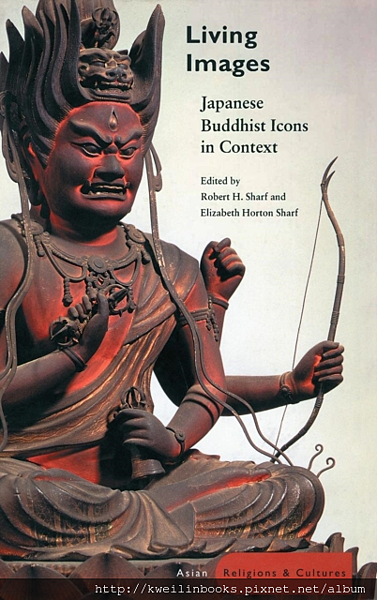Living Images : Japanese Buddhist Icons in Context
佛教形像在日本無處不在,但在佛教寺院傳統的研究中很少受到關注。宗教學者傾向於將佛教圖像僅僅視為宗教理想的象徵或表徵,聖徒和族長的紀念,冥想練習的輔助,或虔誠的焦點。藝術史學家將這些圖像視為適合風格和圖像分析的藝術作品。
然而,這些學者群體都沒有充分認識到日本修道院實踐中圖像和形象崇拜的中心地位和重要性。本卷中的文章重點關注日本佛教繪畫,雕塑,書法和文物的歷史,制度和儀式背景 - 一些是著名的,另一些是長期被忽視的。羅伯特H.Sharf的介紹探討了現代佛教辯護士和西方學者對圖像邊緣化的原因,解決了佛教徒是否真的是偶像崇拜者的棘手問題。 Paul Groner和Karen Brock的文章記錄並闡述了神聖圖像在兩位傑出的中世紀神職人員Eison和Myoe的生活中扮演的重要角色。James Dobbins看到了新土地佛教真實學校的創始人Shinran的新代表,並發現早期的神聖虔誠集中在Shinran和他的形像上,就像佛陀Amida本人一樣。
Robert H. Sharf關於使用Tantric mandalas的論文表明,與收到的觀點相反,這種mandala不是用作儀式可視化的輔助工具,而是用作存在確保儀式功效的活體實體。在每一種情況下,作者都發現這些圖像被精英僧侶和未經修飾的外行人所處理,作為具有相當廣泛性和救贖力的生活存在,並且日本佛教僧侶生活集中在對這些生物的管理和崇拜上。
Buddhist images are ubiquitous in Japan, yet they are rarely accorded much attention in studies of Buddhist monastic traditions. Scholars of religion tend to regard Buddhist images as mere symbols or representations of religious ideals, commemorations of saints and patriarchs, ancillary aids to meditative practice, or the focus of lay piety. Art historians approach these images as works of art suitable for stylistic and iconographic analysis.
Yet neither of these groups of scholars has adequately appreciated the centrality and significance of images and image worship in Japanese monastic practice. The essays in this volume focus on the historical, institutional, and ritual context of a number of Japanese Buddhist paintings, sculptures, calligraphies, and relics-some celebrated, others long overlooked. Robert H.Sharf's introduction examines the reasons for the marginalization of images by modern Buddhist apologists and Western scholars alike, tackling the thorny question of whether Buddhists were in fact idolators. The essays by Paul Groner and Karen Brock document and explicate the crucial role that sacred images played in the lives of two eminent medieval clerics, Eison and Myoe. James Dobbins looks at Shin representations of Shinran, founder of the Shin school of Pure Land Buddhism, and finds that early Shin piety was centered as much on Shinran and his images as on the Buddha Amida himself.
Robert H. Sharf's essay on the use of Tantric mandalas reveals that, contrary to received opinion, such mandalas were not used as aids to ritual visualization but rather as vivified entities whose presence ensured the efficacy of the rite. In each case, the authors find that the images were treated, by elite monks and unlettered laypersons alike, as living presences with considerable apotropaic and salvific power, and that Japanese Buddhist monastic life was centered around the management and veneration of these numinous beings.
Robert H. Sharf (Autor)
Publisher:Stanford University Press
ISBN: 978-0804739894
原價 US 57.5 台幣價 NT$1707




 留言列表
留言列表


 {{ article.title }}
{{ article.title }}